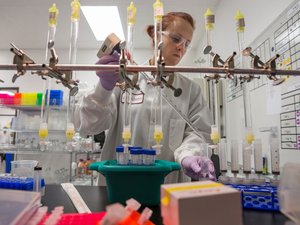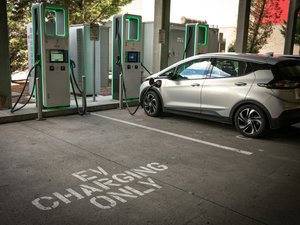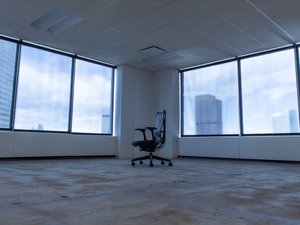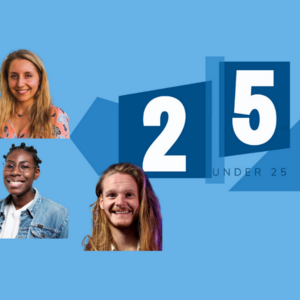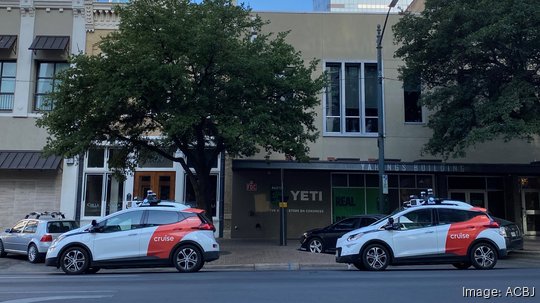
It took Cruise LLC about 90 days from setting up operations in Austin to having fully autonomous vehicles on downtown streets.
In the coming months, it plans to further expand its driverless service to the north and south.
The General Motors-owned company currently operates its robotaxis from 8:30 p.m. to 5:30 a.m. around downtown and near the University of Texas, generally bounded by MoPac to the west, I-35 to the east, Cesar Chavez to the south and Hyde Park just north of UT.
The late hours and limited service areas are set mostly so the company can avoid some of the area's heaviest traffic, although downtown can get pretty busy late at night on the weekends. Its users, who have joined through the company's waitlist, include a lot of students who get ferried from downtown back to campus-area housing.
Soon, its user base in Austin is likely to get more diverse.
"We'll expand geography, we'll eventually expand hours, eventually getting to 24 hours, hopefully very shortly in the next few months," said Mike Staples, general manager of Cruise's Austin operations.
Though the company didn't commit to any exact locations or a specific timeline, Staples said he anticipates the service will expand northward to about U.S. 183 and southward to Loop 360 in the next few months.
While the vehicles will start covering more of the city, there's no timeline for putting them on highways or other high speed roads.
"We'd like to be covering as much as we can," he said. "It's all safety-based."
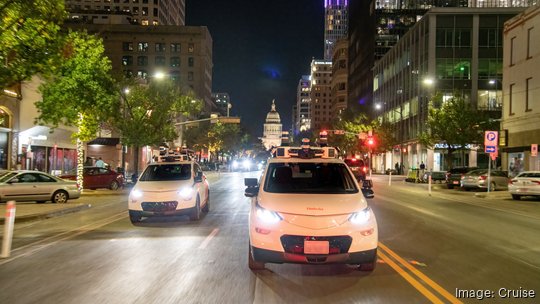
Cruise's expansion comes as autonomous vehicles are increasingly populating Austin streets. One of the company's competitors, Alphabet-owned Waymo, is returning to Austin. The Alphabet subsidiary, which had tested in Austin for years before pulling out in 2019, most recently tested its modified Jaguar I-Pace, its fifth-generation vehicle, across Central and East Austin in April.
Cruise stations its cars mostly at a surface parking lot at Seveth and Trinity, though it also has space in a couple nearby parking garages. The Seventh and Trinity lot is also where its operations team works. There, inside a trailer, the team monitors the vehicles that are out in the field. It will likely expand to other locations in town as it increases its service area.
For now, the big benefit for Cruise is that its AI systems are learning the city and how to manage different situations, including people purposefully jumping out in front of them or messing with them. Meanwhile, the company is gathering feedback from its early users who sometimes report when a vehicle makes an awkward turn or other unexpected moves.
Cruise has been in the news from time to time when its vehicles have frozen in place, sometimes in a lane of traffic. While plenty of traditional cars also break down or are abandoned in the roadway, the autonomous vehicles tend to catch more attention, in part because there might not be anyone immediately there to address it.
The company hasn't shared how often cars stop unexpectedly in Austin. But it acknowledges it does happen.
"Typically, it's when the vehicle senses something that it thought was either unsafe or something else that it didn't understand," he said. "To correct those situations, we have a 24/7 team that's always watching the vehicles, and they can very quickly come in and see what's going on, assess the situation and help the vehicle proceed forward. Or, if needed, in the worst case, we send physical members of our team out to recover it. And that happens very quickly."
Staples acknowledged Cruise vehicles have had accidents. He declined to share any specific numbers for Austin, but said Cruise's vehicles are not at fault in a vast majority of incidents.
Earlier this year, the company said that when benchmarked against human drivers in comparable driving environments, its cars were involved in 54% fewer collisions overall and 73% fewer wrecks with meaningful risk of injury. That could be due, in part, to AI simply not taking the same types of risks that humans often take, as well as having most of its miles on streets with low speed limits.
Meanwhile, the company is hoping to get more people to try the service.
"You very quickly forget you're in a vehicle being driven by a robot," Staples said. "... At some point in time, you start texting on your phone or talking to your friend, and you absolutely forget that there's nobody driving the car."
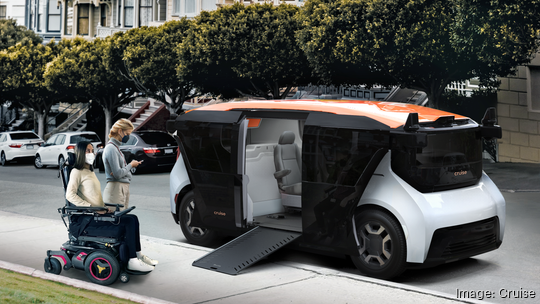
Aside from its geographical expansion, Cruise is also planning to commercialize a new autonomous vehicle, the Origin, by the end of the year.
Austin will be the first city where the vehicle will be used, and you may soon see them on the streets as they begin testing. The van-like vehicle won't have a steering wheel or gas and break pedals. It has a lot of leg space, Staples said, and some of the vehicles will be configured with ramps to make it accessible to people who have mobility issues or use a wheelchair.
"That is the future," he said.
